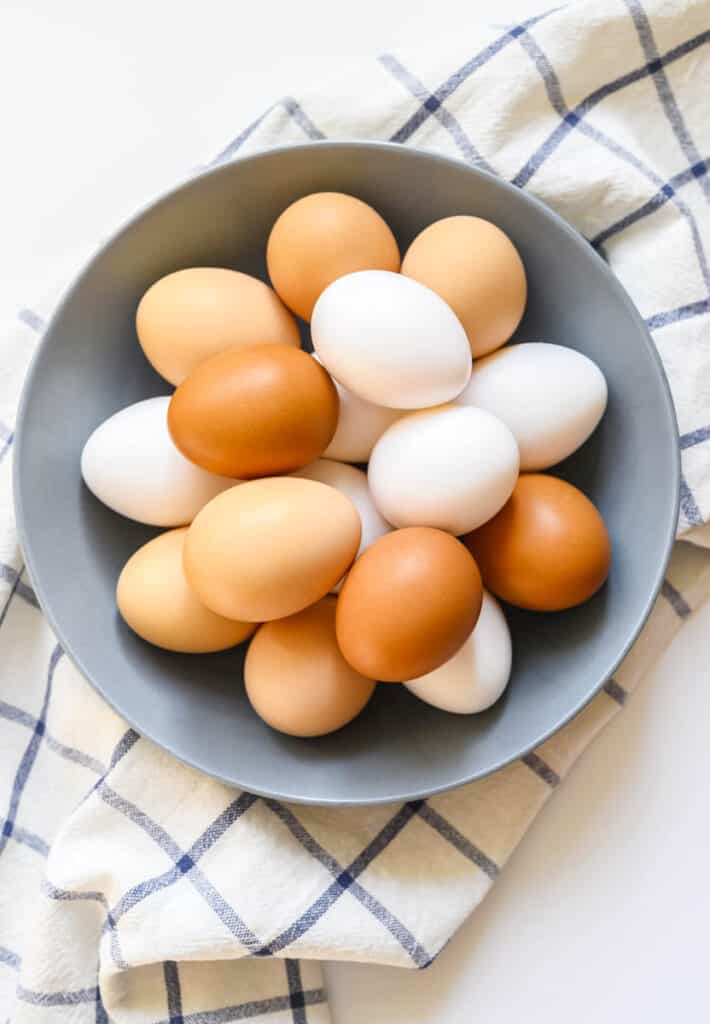The best way to crack an egg is probably not what you think it is.
It’s not cracking the egg on the lip of a mixing bowl. And nope, it’s not cracking an egg with one hand. It’s not tapping an egg with a butter knife either—my home ec teacher taught me that one and I never really got the hang of it, anyway.
If you want the secret to not having bits of shell or half the egg shell in your bowl, learn how to get a clean break. The wrong way will end up having shell fragments in your bowl – and no one wants that!

How to Crack an Egg Perfectly Every Time
I think almost everyone learns to crack eggs by giving them a gentle whack on the edge of a bowl, then pulling the two halves apart. If you’re careful, you probably crack the egg into a separate bowl and then add it to whatever you’re baking or cooking just in case you get some shells in there. But if you don’t want to have another bowl to wash, you probably just crack your egg right into everything else and hope you don’t have to go on a search-and-rescue mission for tiny bits of eggshell.
And if you don’t find them all, well, you might have a crunchy surprise in your brownies!
No more suspense! Here’s the deal: you crack an egg by giving it a firm tap on the countertop, table, or cutting board. Any flat surface will do, but flat is the key word here.
Why flat? Because when you crack an egg on an edge instead of a flat surface, you’re:
- Shattering the shell into lots of tiny pieces.
- Pushing the shell into the egg.
- Introducing bacteria from the shell to the egg.

Why Cracking Eggs on Flat Surfaces Works Better
When you tap the egg on a flat surface, it cracks without shattering. Then, all you have to do is press your thumbs into the crack until the membrane breaks, pull the two halves apart and you’ve got your yolk and white intact, no shards of shell, ready to use in your recipe. Any bits of eggshell will stick to the membrane, rather than going into the egg (and your brownies).
The food safety issue bears repeating—if you like your egg yolks runny when you’re making breakfast, it’s really not good to have the outer eggshells come into contact with the insides. It can cause contamination and if your food isn’t cooked to the right temperature to kill the bacteria, it can make you (or your family) sick.
If you already crack your eggs on a flat surface, you probably don’t get what the big deal is. But if you use the crack-on-the-lip-of-a-bowl method, it’s a game-changer. It might take you a few tries to get the method down, but once you do, I promise you’ll never go back!
Now that you know how to get the best results, I can’t wait to hear if this easy way works for you. I promise that you’ll never crack a whole egg any other way once you try it this way. You won’t have to go through a carton of eggs or worry about finding eggshell pieces in your food.
This is one of the best life skill lessons and is such a basic method. This works with fresh eggs and is the best method for cracking eggs on the side of a bowl or a hard surface.

My Favorite Recipes for Eggs
Now that you know the best way to crack eggs, here are some of my favorite ways to use them!
- Egg White Vegetable Frittata
- Bacon and Egg Breakfast Cups
- Keto Sausage & Egg Breakfast Bowls
- Breakfast Quesadillas
- Fluffiest Scrambled Eggs
Be sure to bookmark my post on recipes for every amount of eggs so you have some ideas at hand the next time you’ve got a few eggs in the fridge that need to be used!









I am an edge of the bowl person and can see the advantage of the flat surface method. My problem is that I had so much practice time on the bowl edge (65 years) that I wonder if I have enough time to perfect the countertop. I have to deal with yard eggs and store eggs which are a different hardness. But I will give it a try!